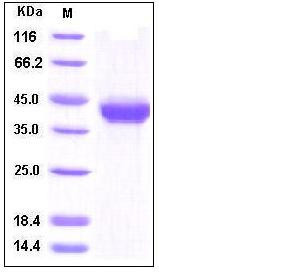Human AgRP Protein (Fc Tag)
AGRT,ART,ASIP2
- 100ug (NPP1877) Please inquiry
| Catalog Number | P10070-H02H |
|---|---|
| Organism Species | Human |
| Host | Human Cells |
| Synonyms | AGRT,ART,ASIP2 |
| Molecular Weight | The recombinant human AgRP/Fc is a disulfide-linked homodimeric protein. The reduced monomer consists of 350 amino acids and predicts a molecular mass of 39 kDa also estimated by SDS-PAGE under reducing conditions. |
| predicted N | Ala 21 |
| SDS-PAGE |  |
| Purity | > 97 % as determined by SDS-PAGE |
| Protein Construction | A DNA sequence encoding the human AgRP (NP_001129.1) (Met 1-Thr 132) was expressed with the fused Fc region of human IgG1 at the C-terminus. |
| Bio-activity | |
| Research Area | Cancer |Signal transduction |Metabolism |Amino Acids |
| Formulation | Lyophilized from sterile PBS, pH 7.2 1. Normally 5 % - 8 % trehalose and mannitol are added as protectants before lyophilization. Specific concentrations are included in the hardcopy of COA. |
| Background | Agouti Related Protein (AGRP, or AGRT), is an endogenous antagonist of the melanocortin receptors MC3R and MC4R found in the hypothalamus and exhibits potent orexigenic activity. AGRP can act as a competitive antagonist to proopiomelanocortin (POMC)-derived peptides at the melanocortin-4 receptor (MC4R), and that this homeostatic mechanism is important as a means of coordinating appetite with perceived metabolic requirement. AGRP is upregulated by fasting while intracerebroventricular injections of synthetic AGRP lead to increased appetite and food intake. Thus, AGRP is a powerful orexigenic peptide that increases food intake when ubiquitously overexpressed or when administered centrally. |
| Reference |
